How Does The Us Spend Money On Financial Aid College
How Do People Pay for College?
Last Updated: October 20, 2021 by Melanie Hanson
Report Highlights. Students use financial aid to pay for 92% of college education costs.
- Scholarships and grants cover $7,500 of annual academic costs per student.
- $120 billion in federal student aid goes out each year in the form of grants, work-study, and loans.
- Annually, parental contribution at $11,862 makes up the largest share of a student's funding sources.
- 71% of college-bound students seek federal aid to pay for college.
Related research includes Average Cost of College | Student Loan Debt Statistics | Student Loan Forgiveness Statistics | Average Cost of Community College | Average Time to Repay Student Loans | Economic Effects of Student Loan Debt | Student Loan Refinancing
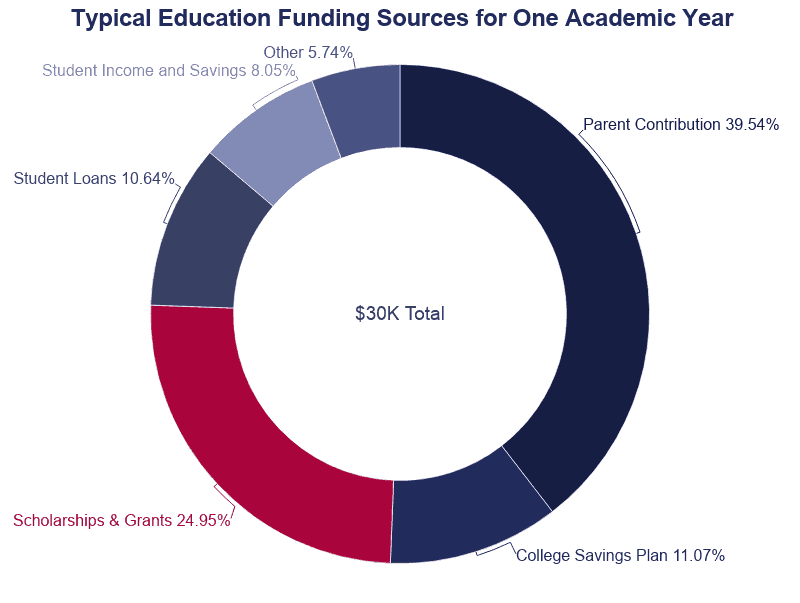
How to Pay for College
College financial aid offices help students determine how they will pay for school. Because schools expect students to need financial help to pay for college, most schools offer free financial counseling services for current and prospective students.
- 84% of students receive some form of financial aid.
- Scholarships and grants cover $7,500 of annual academic costs per student.
- For federal and state government aid, the average award per student is $13,100.
- Students who attend nonprofit private schools receive the most federal and state government aid.
- Parental support accounts for the greatest financial contribution to most students' educations.
- Parental income and savings, parental borrowing, and college savings accounts cover over half of students' educational expenses.
- Excluding college savings plans, $11,900 is roughly how much parents pay for one academic year of their children's education.
- Long-term, high-yield savings accounts and property mortgages are common strategies parents use to pay for college education.
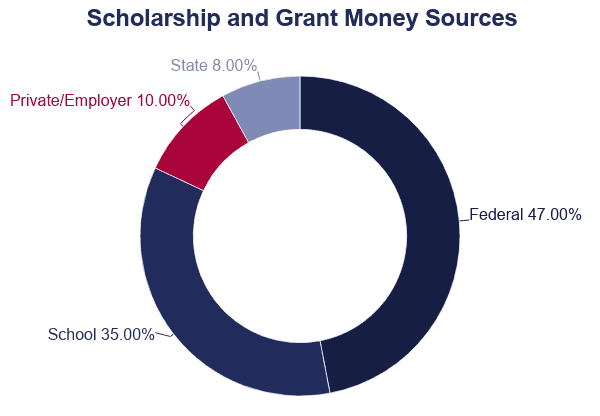
Grants and Scholarships
Grants and scholarships offer free money to pay for college. Innumerable entities offer grants and/or scholarships, including federal and state governments, schools, community organizations, private organizations, businesses, and nonprofits. Some institutions are founded for the sole purpose of providing one or more scholarships.
- Grants from the Office of Federal Student Aid (OFSA) at the U.S. Department of Education (ED) are generally need-based.
- Scholarships are available from other federal institutions, such as those within the Department of Health and Human Services (DHHS) and the U.S. Department of Labor.
- Current and would-be students apply for federal grants using the FAFSA.
- Federal grants are awarded on a year-to-year basis, so filing the FAFSA is an annual requirement to receive this type of student aid.
- Federal grants also require receiving students to maintain eligibility.
- Students who fail to maintain eligibility may be required to pay back the grant money in full or in part.
- Federal grants include the Federal Pell Grant, the Federal Supplemental Educational Opportunity Grant (FSEOG), the Teacher Education Assistance for College and Higher Education (TEACH) Grant, and the Iraq and Afghanistan Service Grant.
- Pell Grants offer the maximum possible payment at $6,345 per academic year.
- Private non-profit schools also offer the most in institutional grants and scholarships.
- Many small, specialty grants are available to students, such textbook grants of $500-$1,000 per year.
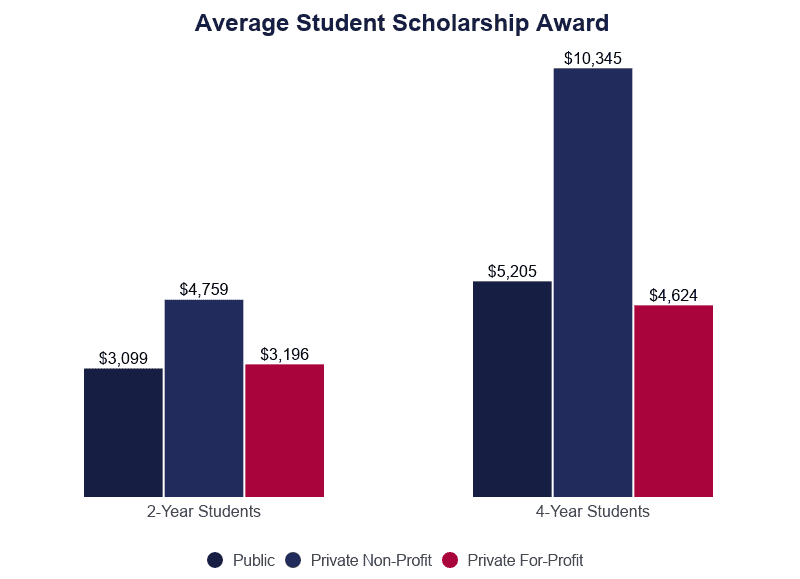
Grant and Scholarship Statistics
Experts advise students to prioritize grant and scholarship applications using data and requirements. This helps students weigh their odds of success. Smaller scholarships for $500 or $1,000 offer much less competition than larger awards.
- 5 million scholarships make $24 billion available to college students every year.
- Scholarships and grants cover 25% of educational costs every year.
- There is enough public and private scholarship money available to give every full-time enrolled student $9,744.
- 63% of all undergraduates receive at least one grant or scholarship.
- 76.7% of full-time undergraduates receive a grant or scholarship.
- 47% of all grants and scholarships come from the federal government.
- 87% of students who receive scholarships receive one from their college.
- 75% of students who are awarded scholarships receive them from private or community organizations.
- 20 million FAFSAs are processed each year.
- 23% of federal grants are Pell Grants.
- By not filing their FAFSA, students miss out on nearly $3 billion in Pell Grants each year.
- 52% of high school graduates are eligible for a Pell Grant.
- 85% of first-time, full-time students attending 4-year colleges receive federal aid.
- 78% of first-time students at 2-year colleges receive aid.
- 31% of college students come from low- to very low-income households.
- States provide more grants and scholarships based on test scores and grade point average (GPA).
- Most private scholarships are less than $4,000.
- The odds of winning a private scholarship are about 1-in-8.
- For some very competitive scholarships, odds are as low as 1-in-500.
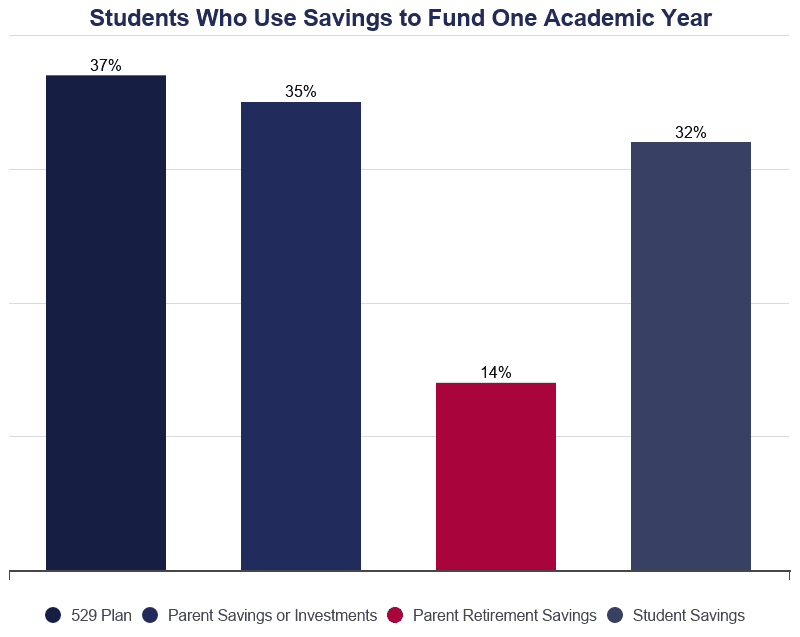
College Savings
High-yield savings accounts are popular for long-term savings with no withdrawals. Programs through the IRS also offer savings programs that include tax benefits. It's common for parents to take advantage of these long-term savings plans on behalf of their children or grandchildren.
- Income and savings cover a majority of academic costs.
- 529 Plans, also known as Qualified Tuition Plans (QTPs) are state-sponsored education savings plans.
- 529s are essentially prepaid tuition plans, allowing the purchase of college credits for future use – but at current prices – at a participating institution.
- Every state's 529 is available to the public, regardless of residency.
- Only certain institutions are approved.
- 529s include tax benefits as authorized by the Internal Revenue Service (IRS)
- Coverdell Education Savings Accounts are available only to those saving on behalf of a beneficiary who is either under the age of 18 or designated special needs.
- A Coverdell Education Savings Account allows investors to put aside up to $2,000 each year.
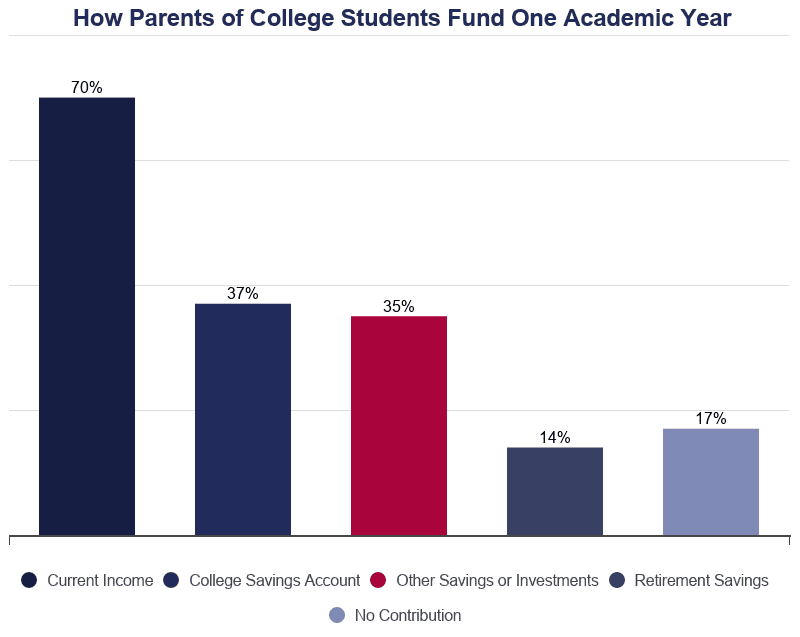
College Savings Statistics
In most families that include a college student, parent income and savings make up the majority of education funding. This is not the case, however, in families where the student is the head of the household or in cases where the student is the primary decision-maker in funding their education.
- Student income and savings cover 8% of education costs.
- Student contributions, including funds borrowed and grants awarded, cover 21% of education costs.
- 54% of students who are the head of their household report borrowing money to pay for school.
- Among students who are the primary financial decision-makers, $27,041 is the average amount they pay to attend college for one academic year.
- When parents are the primary decision-makers, they pay $34,461 for one academic year.
- Parental income and savings cover 44% of college education costs.
- 83% of parents with children attending school pay for a portion of their child's education costs.
- 37% of them withdraw funds from a savings account dedicated to college expenses.
- 14% of parents withdraw funds from a retirement account.
- 35% use other savings or investments to fund their child's college education.
- 0.8% is an average annual percentage yield (APY) for a high-yield savings account.
- 1.25% is a high-end APY for a high-yield savings account.
- A savings account with an APY of 1.25% and a $200 monthly contribution for 10 years will have an end balance of $25,622.45.
- After an additional 10 years, the same account will contain $54,407.56.
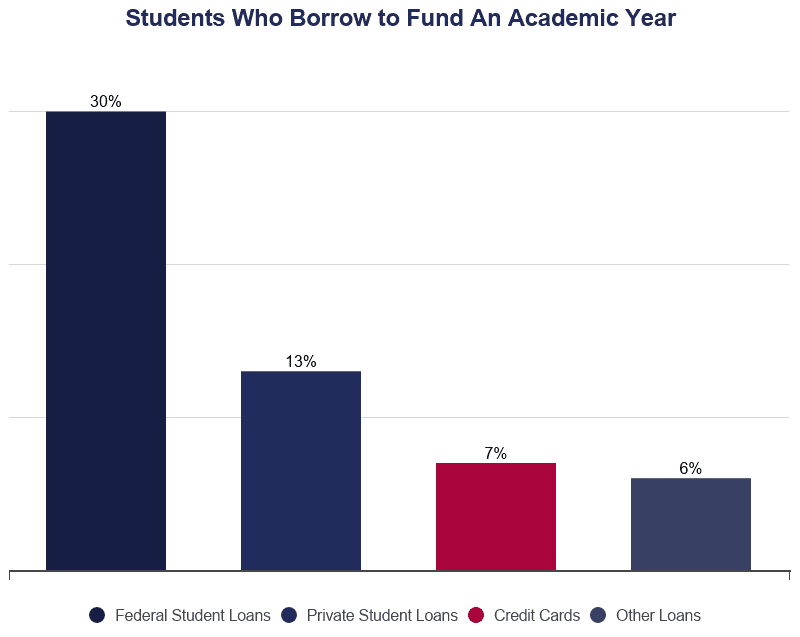
Student Loans
Almost 45 million American adults owe $1.7 trillion in student loan payments. Most student loans come from the federal government. Many private and financial organizations offer student loans, as well.
- Student loans generally begin accruing interest immediately; only subsidized federal loans carry no interest until a student is out of school.
- Federal student aid may be used to pay for tuition, fees, books and supplies, room and board, transportation, and daycare for dependents.
- Students apply for federal loans by filling out the Free Application for Federal Student Aid (FAFSA).
- Undergraduate students can borrow as much as $31,000 with a Federal Direct Loan.
- Private companies may offer loans up to 100% of the student borrower's cost of attendance.
- Most private loans begin accruing interest immediately, though payments may or may not be due until the student leaves school.
- Private companies are likely to charge fees for late or incomplete payments.
- Private companies are also more likely to offer discounts, such as reduced interest rates with automatic payments.
- Some private lenders deal exclusively in student loans.
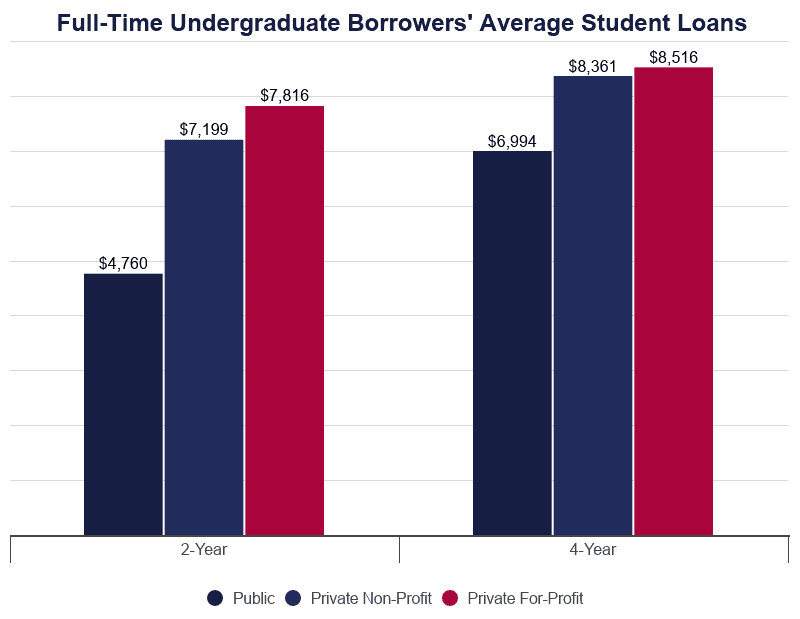
Student Loan Statistics
Most students borrow money to pay for college at some point during their education. Post-secondary students, including those earning certificates and associate's degrees, borrow at least $15,000 to pay for classes.
- 40.5% of undergraduates between the ages of 15 and 23 use loans to pay for college.
- 53% of all students between the ages of 15 and 23 use student loans.
- Student loans cover 21% of annual education costs.
- 34% of students borrow money to pay for college each year.
- 20% of parents borrow money to pay for a child's education.
- 71% of families apply for federal student aid by submitting their FAFSA.
- 7.7% of loans come from private sources.
- The average college student borrows more than $30,000 to attend school.
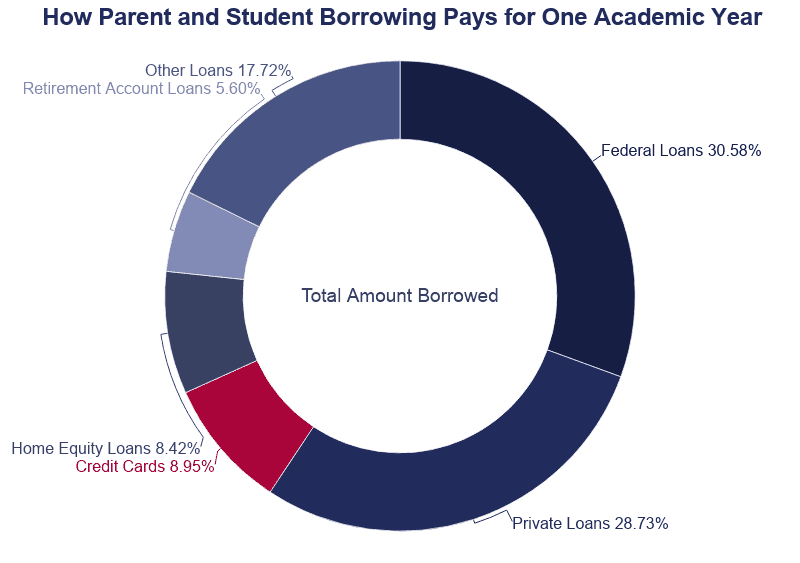
Loan Forgiveness Programs
How students pay for college is a growing concern among education policymakers. As a result, the federal government has launched several student loan forgiveness programs. Loan forgiveness is also known as loan cancelation or loan discharge. It is tough to achieve, but not impossible.
- Most people may become eligible for loan forgiveness through the Public Service Loan Forgiveness (PSLF) Teacher Loan Forgiveness programs.
- Teacher Loan Forgiveness covers up to $17,500 in outstanding loans.
- To have their loans forgiven, most borrowers have to make several years of qualifying payments.
- Federal income-based repayment plans may make a borrower eligible for loan forgiveness after 20-to-25 years of regular payments.
- Borrower defense discharge eliminates part or all loan debt for students who attended schools that engaged in misconduct.
Loan Forgiveness Program Statistics
Every year, thousands of indebted borrowers become eligible for loan forgiveness but never apply. Some applicants submit a request for loan forgiveness multiple times before it is finally accepted. Additionally, acceptance rates vary by program.
- Over 3 million student loan borrowers are eligible or nearly eligible for student loan forgiveness.
- Just 6.7% of graduates eligible for loan forgiveness actually apply.
- 11% of applicants benefit from full or partial loan forgiveness.
- Some loan forgiveness programs have an acceptance rate of less than 1%.
- At one point, the PSLF program accepted 0.03% of applicants.
- In recent months, however, PSLF has decreased its rejection rate by 250%.
Work-Study
Work-study programs help students find part-time jobs that accommodate their academic requirements. These jobs usually include positions within the school, though jobs may be off-campus as well. Off-campus jobs are likely with local non-profit groups.
- The ED's Federal Work-Study Program prioritizes financial need, civics, and finding students work related to their field of study.
- Qualifying and applying for work-study doesn't guarantee employment.
- Federal work-study is available to full-time undergraduates, graduate, and professional students.
- The federal program limits the number of hours a student may work.
- Most students are authorized to work between 10 and 20 hours per week.
- Off-campus jobs are usually at non-profits, public institutions, or community groups.
- Some schools have their own work-study programs independent of the ED.
- These programs may have their own requirements, such as limitations on student eligibility.
- Schools may have contracts with private companies to provide student employees.
- Work-study income does not apply on the FAFSA.
- Work-study students earn an average of $1,847 per academic year.
- 18% of all students participate in Federal work-study.
- 5% of undergraduates participate in work-study.
- 10.5% of full-time undergraduates participate in work-study.
- 43% of full-time students are employed while in school.
- Among those students, 23% work more than 35 hours per week.
- 81% of part-time students are employed while taking classes.
- 58% of those students work more than 35 hours per week.
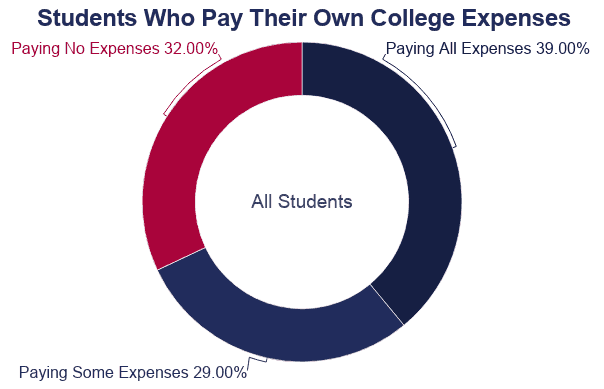
Aid for Military Families
Many types of student aid are available to military personnel, veterans, and their families. There are also reserve training programs and scholarships available through most branches of the military.
- Over 1,000 colleges participate in Reserve Officers' Training Corps (ROTC) programs.
- Army, Air Force, Navy, and Marine ROTC programs all offer scholarships.
- The Department of Veterans Affairs' GI Bill offers education benefits for vets, their dependents, and widows.
- Children of Iraq and Afghanistan service vets who died in combat after September 11, 2001 qualify for multiple additional education benefits.
- Low-interest and no-interest educational loans are also available to military personnel and their families.
Education Tax Benefits
The IRS offers student expense relief in the form of tax credits. If a student is required to pay taxes, they may reduce the amount of their taxable income using these credits. The IRS also offers deductions on student loan interest and special savings accounts for educational expenses.
- The American Opportunity tax credit allows a deduction of up to $2,500 per student, per year for the first four years the student is in school.
- The Lifetime Learning credit allows a claim of up to $2,000 per student, per year on expenses required for college- or career school-related course work.
- Student loan interest may qualify students or their families an annual deduction of up to $2,500.
- Coverdell contributions are not tax deductible, but any growth is tax free until its withdrawn.
- Qualified tuition programs, also known as QTP and 529 plans, offer savings accounts that allow tax-free withdrawals.
- The IRS can also arrange penalty-free early withdrawals from an individual retirement account (IRA) for college costs.
Aid for Foster Care Youth
Children in foster care age out of the system on their 18th birthday. While many students receive financial aid from family into legal adulthood. To aid students who are unlikely to receive aid from parents or relatives, public and private programs offset the financial burden of higher education.
- Educational and Training Vouchers (ETV) for current and former foster care youth are available through the John H. Chafee Foster Care Independence Program.
- Students may receive up to $5,000 each year they are in school through the program.
- Aid is available to former foster youth up to the age of 21.
- States have varied processes for ETV program application submissions.
- The Foster Care Manager at any state Child Welfare Agency has more information about how to apply for an ETV.
- Some states also offer tuition waivers.
- Additional programs are available through DHHS.
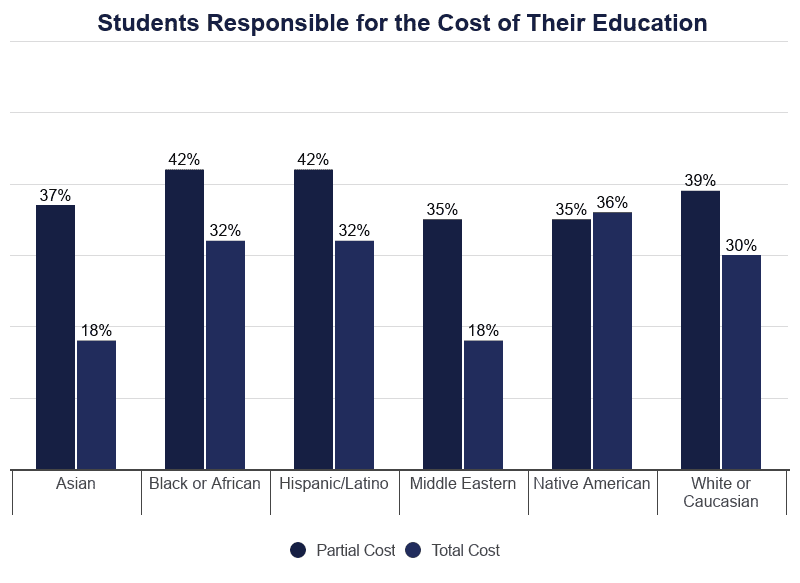
College Funding Demographics
Education funding sources vary from one individual to the next. Organizing people into categories uncovers patterns that indicate what factors may affect the affordability of a college education.
- 36% of Native American students are responsible for financing the total cost of their college education.
- Midwestern students are the least likely to receive any outside help paying for college.
- 35% of Midwestern students are responsible for the entire cost of their education.
- 51% of international students are not responsible for financing their college education.
- 57% of students majoring in public policy are responsible for the total cost of their education.
- 55% of classics majors are not responsible for financing any of their education.
Sources
- United States Department of Education (ED) Office of Federal Student Aid (OFSA), Data Center
- National Center for Education Statistics (NCES), Digest of Education Statistics
- U.S. News, 12 Ways to Cut Your Textbook Costs
- U.S. News, Do Students Have to Pay Back Financial Aid?
- U.S. News, Best Private Student Loans of 2020
- Stanford University, 8 Things You Should Know About Federal Work-Study
- NCES, The Condition of Education
- Sallie Mae, How America Pays for College 2020
- Internal Revenue Service (IRS), Publication 970 (2019), Tax Benefits for Education
- CNN, How The Average Family Pays for College
- LendEdu, Who is Paying for College? It Might Depend on Race or Institution
- U.S. Securities and Exchange Commission, An Introduction to 529 Plans
How Does The Us Spend Money On Financial Aid College
Source: https://educationdata.org/how-do-people-pay-for-college
Posted by: romriellsignatich.blogspot.com

0 Response to "How Does The Us Spend Money On Financial Aid College"
Post a Comment